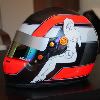kalinka wrote:Lindz wrote:Anyways, even if it is more than 20mm (it PROBABLY is, based on an ESTIMATION from the photos), where is there a rule that says 'during full speed and maximum aerodynamic load, the wing cannot flex more than 20mm'? The rule is that it cannot flex more than 20mm when 100kg per endplate is applied in a static controlled environment. If you need explanation on HOW they are able to get the wing to LEGALLY flex more than other teams, you obviously haven't been reading this thread.
Yes, but there is another rule too, and if you're reading this forum from the beginning you know what I mean, so stop this thing. There's no loophole in regulations for this, it's just they found a way to cheat the test. It's my opinion, but you can find opinions amongst your and mine way too as much as you want. There'll be always arguments along these two regulations, and we can't argue much more, until FIA change the test method.
As for video evidence, there is number of examples when there was no other evidence, and FIA banned things based on these videos. Even there wasn't any attempt to measure things on video footages, it was enough to see that something is flexing....so there's my ( and others' ) problem with this situation. But there are explanations and examples in this thread for this. But it's nor worth to write this down here 1000 times pro-contra.
If you're so confident that you've found how Red Bull are breaking the rules (and surprisingly the whole of the F1 Paddock have missed it) then stop speaking so vaguely.
Video evidence? Is used to bring light to an area that is possibly in breach. If that area has no regulations (such as a flexible rear wing which would close a slot gap under load) then the video evidence is used to change the part or add/amend new regulations. In the case that the part is videotaped possibly breaching an existing regulation, the part is re-tested very carefully and thoroughly to the definition of the regulation. Such as a wing that is not allowed to move (no movable aero devices) but it is allowed to flex (20mm under 100kg load at endplate). This in itself is conflicting, since flexing is movement. But the spirit of the movable aero rule is against 'powered' or controlled devices. Flex is a natural occurrence since nothing is ever completely rigid. The rule defines the allowed flex at prescribed weight, but says nothing about higher-than-prescribed weight. I assume that their thinking was that any higher-than-mandated load on the wing would come with an increased drag penalty such that it wouldn't be worth restricting. They obviously know about the loophole, and they are obviously fine with it. Just like a DDD.
So...
You think it's breaching the reference plane? Or the 75mm above reference plane mandated for a static wing? If the reference plane intersects the ground, something can touch the ground without breaking the reference plane. Likewise, the wing is able to legally flex 20mm with a 100kg load, making it 55mm above reference plane. How much is legal with more load? It's not defined. There is no precedent for deflection with higher-than-100kg load on the endplates.
The geometry of the RB7 with it's rake is such that the reference plane is under the ground plane at speed, so while the wing is flexing at it's maximum and it's close to the ground, it's still higher than the reference plane and possibly even the 55mm height (20mm deflection). Again, if it's flexing more with more load, there is no limit against that.
You think the wing is a device whose sole purpose is to bridge the gap between floor and ground plane? It clearly is not. That rule is referring to skirts and other movable pieces that would CONSTANTLY be in contact with the ground, thus creating a bridge. A bridge is something that can reliably and consistently cross an obstacle, is it not? A wing the flexes and occasionally come CLOSE to the ground is in no way designed to be a bridge, nor is it consistent enough to be considered as such.
That takes care of 3.15 and 3.17, the supposed smoking guns in this case.
It clearly passes the FIA's load tests and nobody in the paddock (besides perhaps Lewis Hamilton) nor the FIA have publicly stated that they think this wing is illegal.
Add to the fact that I, amongst many others, have proposed numerous legal and rational explanations of how they are achieving the flex and proximity to the ground (rake, rear suspension heave, front heave, aero load, AoA, suction from ground effect, construction techniques, advanced computer modeling programs), and I still find it thick that people are still arguing the legality of this. At least bot6 and a few others from the original start of the thread were bringing up rules in which it may be breaching and some of us were searching to see if they were in fact being breached or if not, how it was circumvented. It was exploratory and fun and I think between all the banter and theories, we've actually learned quite a bit about the RB7.









